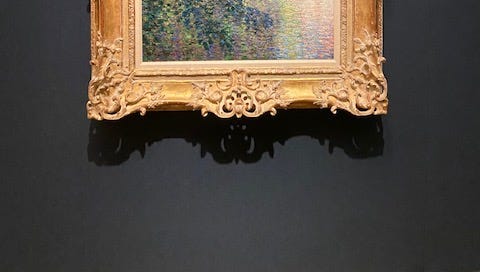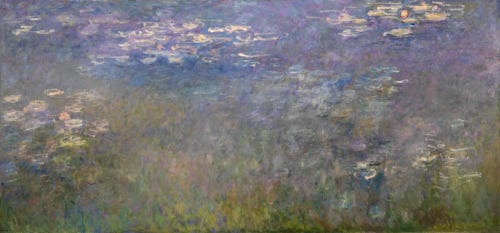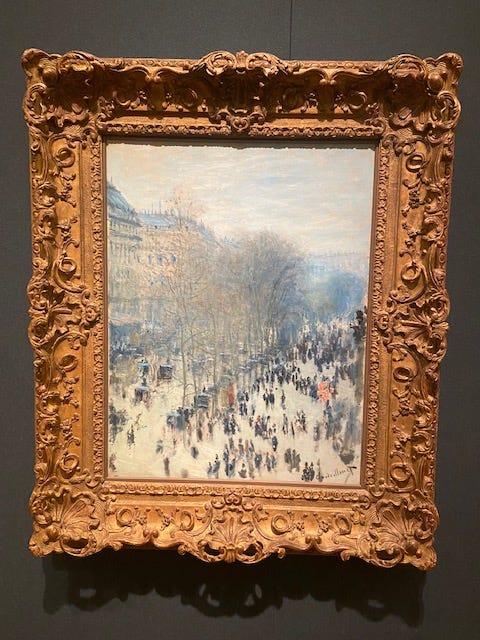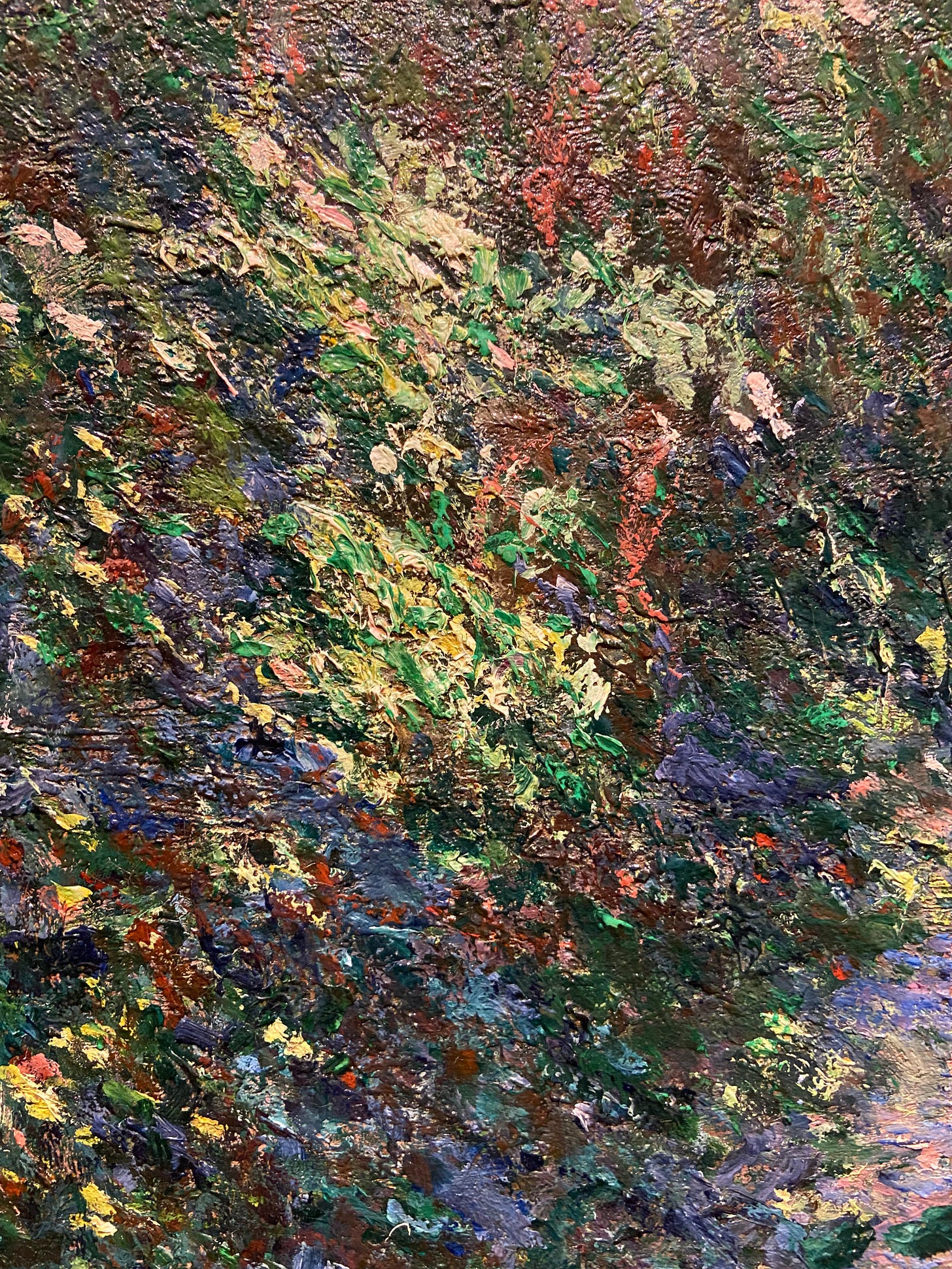What We Are Looking At: Water Lilies by Claude Monet
Claude Monet, French 1840-1926, Water Lilies (Nymphéas), 1915-1926
French Impressionist Claude Monet’s (1840-1926) Water Lilies at the Nelson Atkins Museum of Art in Kansas City. Painted as part of a series of approximately 250 oil paintings of Monet’s garden in Giverny, France during the last 30 years of his life, this painting was one part of The Agapanthus Triptych done during the last 10 years of his life 1915-1926. Soak it in, it’s lovely.
Not a Great Start.
So my plan for the first installment was do a familiar work - Claud Monet's Water Lilies at the Nelson-Atkins Museum of Art in Kansas City. I knew I didn't have a lot of time this week to go look at art, but Thursday was open and the museum is a few minutes from my house. I had already done what reading I wanted to do about it and had a rough outline of what I would be writing.
Then I remembered Thursday was my dead sister Heidi's birthday - she died of cancer in November of 2019, and I had lunch plans with my other sister. Which wasn't going to make it impossible but it was just another thing I had to do. Ultimately, I knew it would be fine because the Water Lilies are incredibly calming. When you come up on the painting, it dominates the room. You know it is Real Art because it has its own bench in front of it. Kids from the art school and old people sitting and looking at it in wonder. So Thursday morning I rushed through work, then got to the Nelson at about 11am. It is a lovely size museum (and it's free), so I knew I could get in and out quick.
It is a classic museum, with the elaborate marble floors and classic sculptures greeting you. I know right where I'm going and head into the gallery where it lives. But the bench is gone. And so is the Painting. I'm already an anxious person, and I don't really have time for this project, and the whole point was to force a little serenity in my life. And now there is no painting. And no time. And I have to go to lunch with my living sister so we can dwell on the dead.
Where the painting is supposed to be, there are other French Impressionists. And there is a Monet from the beginning of his late period when he painted water lilies.
And I try to force it upon myself, but it's not happening. All I see are its flaws. And my own flaws - anxious and hurried with misguided ambitions.
So I walk around the rest of the gallery of impressionist art. I find another, even earlier, Monet.
The thing about the Water Lilies, is that they are the culmination of an idea. You can see in both these other paintings that we are looking from the perspective of the artist. We are standing where the painter was standing, looking at what the painter was looking at. The goal is to appreciate the subject of the painting.
When critics first saw these types of paintings, they called them unfinished. The derisively referred to them as “impressions” of things, not a good representation at all. And it’s ironic as I’m looking at this picture of a Paris street, Boulevard des Capucines (1873-1874), with all the little people with their little hats and carriages, among the buildings and the trees and the gray sky of the horizon - living their little 1873 lives. And I’m thinking, look at all these people late for shit, couples fighting about what to have for dinner, two men in hats talking about whatever two men in hats talked about in 1873. And I’m frustrated because I was hoping to put my mind at ease with a giant painting of nothing. But it’s not here.
I reluctantly return to the Mill at Limetz (1888), and I take some deep breaths. We are still looking at a scene. Monet, standing on the bank of a pond of some sort, painting a picture of a mill. The light is ethereal and the colors calming. I find the colors Monet uses to be so calming that I googled it, and it turns out there are “scientifically proven” calming colors.
In the Mill at Limetz, I think Monet is trying to get to the essence of the moment. That feeling we get when we look at sunsets or the Grand Canyon or whatever, and we feel something like amazement and wonder. But instead of something grand, he is painting an ordinary mill, with light dancing off the water and the trees, and it’s pretty great. It’s like when you are standing in a park next to a big oak tree and the wind blows all the leaves in unison and it almost looks like a school of fish all turning the same direction.
And as great as it is, the Water Lilies are better. Because the subject of the painting switches from the thing in the painting, to the experience of seeing something worth seeing. When we all look at the Grand Canyon and say “wow” what does that mean? These are paintings about what it means to feel “wow.”
Monet told the Dutch critic W. G. C. Byvanch that he was painting the experience of certain phenomena rather than the phenomena themselves. And in the Water Lilies he moves away from place and tries to get to something else. A critic at the time they were first displayed said of the them, “No more Earth, no more sky, no limits now." When you look at the Water Lilies you are no longer standing where an artist was standing and seeing what they are seeing, you are seeing something new. You are not looking at a picture of the Grand Canyon - you are seeing the thing itself. You are there.
When you stand close to a Monet, you can see the paint piled up. The dabs of color strikingly opposed to each other, but somehow blending together. It’s like looking into a drop of water. The whole universe is in there. But what you see, is what you take with you. If you think the world is meaningless you won’t see anything at all. If you think the world has to have a prior order, an agreed upon structure (usually provided by God) to be made sense of, then you might not see anything, or you might (depending on your theology). If you are like me, a person who really hopes that this world is meaningful as it is - that the way things are and the way we experience it matter - then it’s incredible.
I think the hardest thing people have to face when looking at art is to be courageous enough to admit that life can be meaningful. We are so cynical - and we come to it honestly. A millions of people died of COVID and does anyone care? A few years ago some guy went into a kindergarten class and killed all the kids and we shrugged it off. A pretty solid defense mechanism is to convince yourself that none of it matters anyway. We can slide by on a philosophy cobbled together from the golden rule and doing the best you can. But you can’t deny that as much as we share the horrid experiences of COVID and war and violence and hatred, that so too we share some experience of something we might call wonder or joy. Maybe now we would say, it got me in my feels? Maybe just “Wow.” And though the classic tradition had a small view of what was allowed to represent that good thing, we are currently bending the rules of what the meaningful experience can be. But what I like about Water Lilies is that it is old school. It sets out to show you something that proves life is meaningful and incredible and worth living. I think it succeeds.
But something else happened between the Mill and the Water Lilies that makes Water Lilies feel different than the earlier works - The Great War and the Spanish Flu.
Spanish Flu and COVID
For most people COVID started sometime in early 2020. But for me COVID started in the summer of 2019, because COVID is not a disease it’s a traumatic experience. My nightmare started in the summer of 2019 when my dad got a gall bladder infection and it became, in hindsight, more likely than not that my sister, Heidi, would not survive another year.
Trauma has a way of building on itself. You get one thing, and then another, and then things that maybe aren’t really a trauma, well they get thrown in there too. I could list all the stuff that’s on my COVID trauma list but it’s too long. I will say it includes death, and fear, and Donald Trump sticking bleach up his whatever. And it is not over. I want it to be over. But I feel like Ukraine is part of my COVID story, and that is not resolved, and people still die from COVID, right? And though my kids are back to school, we are still talking about “normal grade levels” as if that can even exist.
A strange part of living through a public trauma, is that it doesn’t seem real. It was that way after 9/11. I lived in NYC at the time, and it had the same disconnect. Like everyone knew it happened, and that we were going to shop our way out of it, and then go kill Iraqis and put on patriotic pins and then everything would be good to go. And it was insane. No matter how real it was, it still seemed impossible that planes flew into The World Trade Center buildings and they fell down, and thousands of people died, and we all went back to work and got on with our lives.
Just like COVID Times. Just fucking crazy. But here we go.
And we are so desperate for it to be over that everyone is trying to write the history of it, but no one even agrees what is happening. And it makes you wonder if “shared humanity” is possible.
So when Monet was painting his water lilies, World War I, the Great War, was being fought 50 kilometers away. His own son Michael was called to fight in 1915. He was encouraged to leave his studio in Giverny, but he said, “if those savages must kill me, it will be in the middle of my canvases, in front of all my life’s work.” And right when the war is ending in 1918-1919, the Spanish Flu shows up and kills 20-40 million people (COVID has killed about 7 million according to the top google search result). On the one hand I can’t even imagine, but on the other hand, I totally can.
A day after the armistice, Monet wrote to his close friend, the French Prime Minister Georges Clemenceau, proposing to give two works from his Grandes Décorations to the nation “to honour the victory and peace.” Unfortunately France was out of money and they couldn’t build a place to keep them. It wouldn’t be until after Monet died that they would be able to display the Water Lilies. There is a good story about that here.
Of course it was a success when it opened. The critic Jean-Louis Vaudoyer put it this way, "None of the earlier series…can, in our opinion, compare with these fabulous Water Landscapes, which are holding spring captive in the Durand-Ruel Gallery. Water that is pale blue and dark blue, water like liquid gold, treacherous green water reflects the sky and the banks of the pond and among the reflections pale water lilies and bright water lilies open and flourish. Here, more than ever before, painting approached music and poetry. There is in these paintings an inner beauty that is both plastic and ideal."
We need to be reassured of our shared humanity. And to do that, you have to be able to see both the bad and the good.
When I look at the Water Lilies I see the war and famine and destruction, but I also see the beauty and the peace. I see all the great and horrible events that have shaped our current life, from the ancient disasters to the nuclear bomb, it’s all there. For every personal tragedy is a reflection of the loss that is inherent in being a human. But so too is every rebirth, every new flower, every new spring.
Whenever the hell the painting comes back to Kansas City, I’m going to go down, sit on the bench, take a deep breath and say “yes, this is good.”
So this week, that’s what we’re looking at: the war and the peace and the death and the rebirth found in a French pond 100 years ago: Monet’s Water Lilies.









Thanks. That was really insightful. I have never "got" art and I'm hopeful this series is going to be helpful in that regard.
This was great.
Last Friday I took my youngest daughter to the MFA in Boston and we sat in front of ‘Flowerbeds at Vetheuil’ and spent an hour drawing it with her colored pencils. It was fantastic, and hard, trying to understand the color and how it all works together. I can’t think of a deeper meaning to life than creating art (even crappy copies) with your daughter. And it was also fun.